Create Adaptive 3D Fragment |
  
|
To make a 3D model suitable for use as an adaptive 3D fragment, a set of objects (adaptive elements) needs to be defined, whose geometry will be driven by the assembly objects.
Upon calling the Adaptive Fragment command, you can fill in the item Name in the parameters window (optional). The entered string will be the name of the 3D fragment in the model. If the name is not specified, the default "Part_No" is used in the model. The Comment item may contain a text explaining the intended uses of the given 3D fragment.
To add a new object to the list of adaptive elements, select it in the 3D view window or in the model tree. The selected element appears in the upper list, Adaptive Elements, in the parameters window. Upon selecting an object, the system automatically adds to the list the topological elements of that object (edges, vertices, faces) that are referenced by the object's children.
The Adaptive Elements list provides an intuitive display of interrelations of the selected object with its children and adds a capability of selecting elements that are not at the top level of the model hierarchy as the geometrical parameters.
The contents of the adaptive elements list can be managed by graphic buttons in the parameters window:
- for the Adaptive Elements list:
•![]() transfer to the list of external parameters
transfer to the list of external parameters
•![]() deleting current element;
deleting current element;
•![]() deleting all elements;
deleting all elements;
•![]() deleting unused elements. This button becomes accessible if the list contains objects deleted from the model. Such objects are marked in the list by the icon
deleting unused elements. This button becomes accessible if the list contains objects deleted from the model. Such objects are marked in the list by the icon ![]() .
.
- for the External Elements list:
•![]()
![]() moving current element around the list;
moving current element around the list;
•![]() creating a new folder. The list of external parameters can be organized into a tree structure, by distributing the list elements over different levels or over different folders in one level. When inserting a 3D fragment into a model, its geometrical parameters will be displayed according to the defined structure;
creating a new folder. The list of external parameters can be organized into a tree structure, by distributing the list elements over different levels or over different folders in one level. When inserting a 3D fragment into a model, its geometrical parameters will be displayed according to the defined structure;
•![]() renaming selected external parameter. For each external parameter you can assign the meaningful name;
renaming selected external parameter. For each external parameter you can assign the meaningful name;
•![]() deleting current element;
deleting current element;
•![]() deleting all elements.
deleting all elements.
When creating or editing a 3D fragment in the assembly context (the "Top-down" design flow), the Adaptive Elements list is built automatically. The system creates this list based on the objects that are referencing assembly adaptive elements (3D profiles, workplanes, 3D nodes, etc.). If a 3D fragment is intended for insertion in other assembly models, the user can compose the list of external geometrical parameters by using the already built Adaptive Elements list.
Example of Creating an Adaptive Fragment
To give an example of composing a list of external geometrical parameters, let's consider a 3D fragment that defines creation of protrusion (see the picture at the beginning of the chapter). The first item in the Adaptive Elements list will be the 3D profile based on which the extrusion is created.
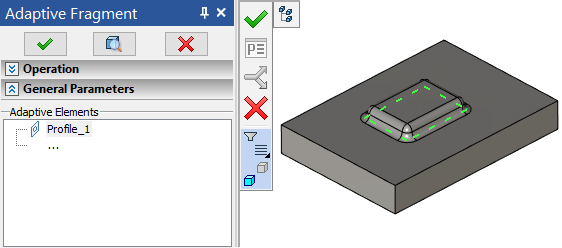
The second element of the list is assigned to Extrusion_0. At the same time, the system adds the face of this operation to the list, since the face is the parent element for the subsequent Extrusion_1 operation.
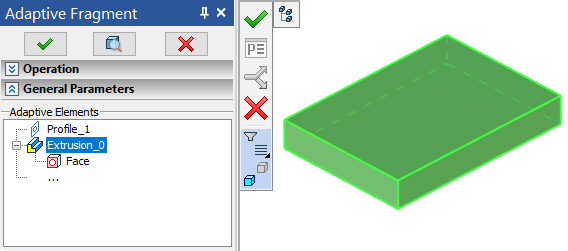
The set of object types allowed for selection is defined by the option:
|
<V> |
Select type of parameter |
The drop-down list will help setting up the internal command filters for selecting objects of a certain type: workplane, worksurface, coordinate system, operation, 3D path, 3D node, 3D profile.
The default active option in the automenu is:
|
<M> |
Show parameter in Fragment document |
It enables highlighting of the objects that are not at the top of the model tree hierarchy. For example, if the given operation is active, then upon selecting a face of the operation Extrusion_0 in the list of objects, this face will be highlighted in the model (at the same time, all children of Extrusion_0 will be temporary removed from the 3D scene).
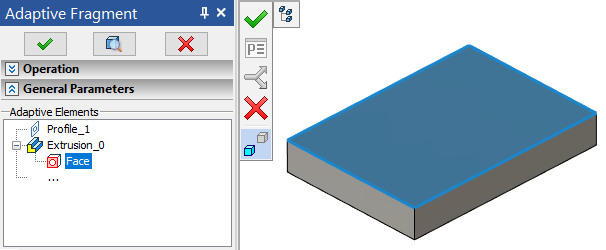
If the option is not active, then highlighting will only work if the current element in the list is a top-level operation.
The next required action is composing the External Elements list. This list gets the elements from the "Adaptive Elements" list, that will be instantiated upon inserting the 3D fragment into an assembly model.
We recommend putting in the list of external parameters all topological children of the model object, that were entered in the upper list, and instantiate them as values in the assembly.
Suppose, the external parameters list of an adaptive 3D fragment does not contain all topological children of the selected model object, or some of those objects are not instantiated upon inserting this fragment into an assembly. In this case, upon regenerating the 3D fragment model (at the time of inserting it in the assembly) errors will occur when creating the operations (or other objects) that are based on the uninstantiated topological elements.
To avoid a large number of unnecessary dependent elements in the list of geometrical parameters, prefer building the 3D fragment model in such a way that the Adaptive Elements used as geometrical parameters are at the highest possible level in the model tree structure. Move elements by selecting in the upper list and pressing the graphic button ![]() . You can enter a comment for any element in the list of external parameters. The entered string will pop up as a tooltip in the parameters window when selecting the parameter instantiating value in the command 3D Fragment.
. You can enter a comment for any element in the list of external parameters. The entered string will pop up as a tooltip in the parameters window when selecting the parameter instantiating value in the command 3D Fragment.
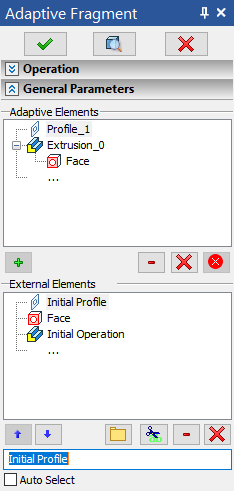
If necessary, an external parameter can be renamed by editing the default name that is the same as the name of the model object. When selecting an element in the list of external parameters, the respective element is automatically highlighted in the list of model objects. This allows easily tracking the renamed model object that was used for creating an external parameter. The
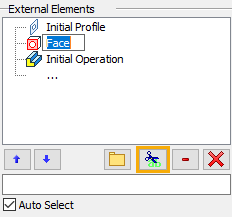
Auto Select flag can be used for objects whose children are external parameters themselves. For instance, in the current example, Auto Select can be set for Extrusion_0 in order to reduce the number of items to select.